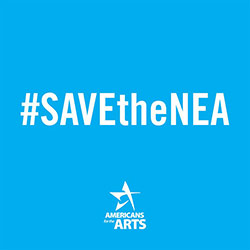The following piece was written by Chance Friedman, a 16-year-old student who has participated in Paper Mill’s Arts Education Programs.
By Chance Friedman
 Youth arts classes and education. Works from emerging playwrights and artists. Community performances and concerts. Programs that support these aforementioned ideas are now facing substantial danger under the proposed federal budget. In recent years, the trend to discount arts education has become increasingly prevalent in school curricula throughout the United States. Regardless of the extensive research that explicitly states the need for such training, this issue has taken center stage yet again as our current administration seeks to eliminate the National Endowment for the Arts, otherwise known as the NEA. The National Endowment for the Arts is an organization that provides support and funding for projects exhibiting artistic excellence. This vital federal agency recognizes the impact that artistic fields including theatre and music have on society. It is essential to understand that the defunding of the NEA would not only be devastating to the arts community, but equally so to the youth of this country.
Youth arts classes and education. Works from emerging playwrights and artists. Community performances and concerts. Programs that support these aforementioned ideas are now facing substantial danger under the proposed federal budget. In recent years, the trend to discount arts education has become increasingly prevalent in school curricula throughout the United States. Regardless of the extensive research that explicitly states the need for such training, this issue has taken center stage yet again as our current administration seeks to eliminate the National Endowment for the Arts, otherwise known as the NEA. The National Endowment for the Arts is an organization that provides support and funding for projects exhibiting artistic excellence. This vital federal agency recognizes the impact that artistic fields including theatre and music have on society. It is essential to understand that the defunding of the NEA would not only be devastating to the arts community, but equally so to the youth of this country.
I’m sure you are all aware that public schools in the United States rely heavily on government funding to enhance the lives of students through various courses – not solely the arts. When schools struggle to stay within their budget, arts programs are typically the first to be cut despite their clear academic worth. Nonetheless, an arts education transforms unmotivated students into inspired learners while developing critical thinking, creativity, and communication skills. These attributes are imperative to lead a successful life, no matter what one may pursue in his or her future. Be that as it may, this argument is still not considered enough to protect the support of arts programs in public schools. Imagine a child who has begun to develop his or her artistic talents, finding a metaphorical home inside the arts community when he or she is suddenly robbed of this education. Imagine your brother or sister as this child. Imagine your friend as this child. Imagine your own future son or daughter as this child. The notion that fine and performing arts are deemed non-essential in today’s teaching cannot be accepted, and this is why we must defend the National Endowment for the Arts. Linda Moran, President and CEO of the Songwriters Hall of Fame best describes the indispensability of the NEA when she asserts,
“Music and arts are essential to life and our humanity and in the nurturing of our souls. Removing access to that which allows the exploration, discovery, and development of one’s talents would be a travesty of epic proportions. Our future songwriters, musicians, and artists must be fostered, not ignored” (Olson 1).
Policymakers and officials may falsely assume that cutting arts programs from schools will redirect children toward pursuits found more “worthy,” but this is extraordinarily inaccurate. Rather, the NEA conducted a study explaining that low-income students with access to arts programs tend to have better academic results, better workforce opportunities, and more civic engagement (Gifford 1). It may be difficult to comprehend the rapid decrease in arts prioritization as we are fortunate enough to live in Basking Ridge, but the NEA continues to provide highly needed resources and funding to low-income areas.
In absence of government support through the NEA, school districts would have to look to their community and local corporations for arts funding. Private donations would be the only feasible solution to continue arts education in a country that increasingly neglects the arts. Nearby theatres or performing arts centers could comparably contribute to arts programs in schools, and many already do. Paper Mill Playhouse, recipient of the 2016 Regional Theatre Tony Award, supports high school arts in a myriad of ways, including their annual “Rising Star Awards” and “Adopt a School” programs; both are designed to encourage the inclusion of arts as playing an integral role in New Jersey’s educational system.
Depending on private support and donations, however, is not the answer. This is in no way a substitute nor a replacement for the vital organization that is the National Endowment for the Arts. The administration may argue that the eradication of the NEA is necessary to strengthen our defense, but what exactly is there left to defend? The bottom line is that the NEA connects communities through arts and culture, and this is work that must be protected.
Preserving the National Endowment for the Arts is contingent on us, the students, the learners, the artists. We, the people, must raise awareness to this cause through petitions. We, the people, must reach out to adults who have succeeded in the creative world despite disadvantaged upbringings and allow for their stories to be told. We, the people, must contact our congressional representatives. This is how we can, should, and will protect the National Endowment for the Arts.
At a time of unprecedented division in our country, it is important that individuals unite through the arts and understand the essentiality of the NEA. Representing only 0.00004 percent (four hundred-thousandths) of the $3.9 trillion federal budget, the benefit to society far outweighs the negligible cost to our government; thus, it is unjustifiable for today’s administration to eliminate the National Endowment for the Arts.
Works Cited
Olson, Cathy Applefeld. “What Could Happen If Trump Defunds National Endowment for the Arts? Experts Weigh In.” Billboard. Billboard, 1 Feb. 2017. Web. 18 Mar. 2017.
Gifford, Sally. “National Endowment for the Arts.” New NEA Research Report Shows Potential Benefits of Arts Education for At-Risk Youth | NEA. National Endowment for the Arts, 30 Mar. 2012. Web. 18 Mar. 2017.



















